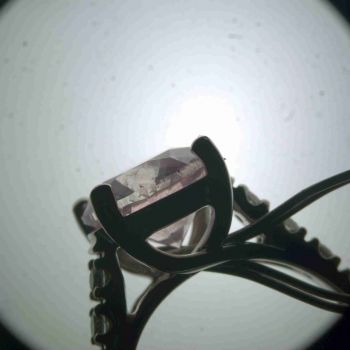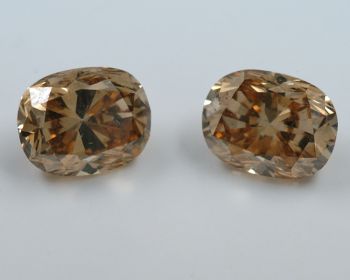RAPAPORT... EGL USA Laboratories identified a new color surface enhancement process that is observed primarily in pink and orange diamonds.
Laboratory testing indicated that this new color enhancement process, which is more durable than previously known coatings, does have limited color stability.
In recent months, an unusually high number of fairly identically colored pink diamonds were submitted to the EGL USA laboratories in New York and Vancouver, Canada, according to EGL.
Casual observations indicated the color to be uniform and close to “natural” colors. Under standard microscopic tests, pink graining was absent. In addition, colored flashes were present on the pavilions of some of the diamonds. In some cases, the body color was found to be uneven on both the crown and pavilion and a few diamonds exhibited a lack of color in nicks on facet junctions (as pictured on the right.) 
EGL reported that an unexpected observation was that the coating was resistant to scratching by a metal probe. Additional colored diamonds (orange, purple, and blue) were obtained showing similar characteristics. Investigation of the source of these diamonds revealed that some were disclosed by suppliers in the United States and Asia as “infused” or “HPHT treated.”
The initial observations were found to be inconsistent with this disclosure terminology, but were instead consistent with a new generation of surface treatments just coming into the marketplace. These are proprietary coatings, based upon nanotechnology, designed to impart color and provide increased resistance to mechanical abrasion.
The research laboratories of EGL USA Group in New York and Vancouver collaborated with the University of British Columbia, Drexel University, and the College of Staten Island (New York) to determine the existence, nature, and stability of the coatings.
Initial results by SEM/EDS (Scanning Electron Microscopy/ Energy Dispersive Spectroscopy) and XPS/ESCA (X-ray Photoelectron Spectroscopy/ Electron Spectroscopy for Chemical Analysis) revealed the presence of carbon, oxygen, silicon, nitrogen and sodium, and concentrations of gold.
Raman spectroscopy revealed a non-diamond film on the surface of the diamonds. The spectrum was close to silicon carbide with additional peaks that correlate to different ceramic phases added to the coating. SIMS (Secondary Ion Mass Spectroscopy) depth profile showed this multi-layer surface film to be less than 1 micron. These results are consistent with the deposition of a color-imparting agent through ion plasma assisted deposition, with concurrent deposition of a diamond-like carbon layer, alumina, nitride or carbonitride coatings for increased durability, as described in pending patents.
As this diamond coating appeared to have increased durability compared with previous coatings, stability tests were conducted on pink, orange, yellow and blue colors. The color was stable to ultrasonic and steam cleaning. The color had limited stability (depending upon the color itself) when exposed to temperatures of 300ºC to 800ºC, unlike the previous unstable coating process. At higher temperatures of 900ºC to 1200ºC, however, the color was lost from the coating substance. All the coated diamonds reverted to their presumed original light brown color after being boiled in sulfuric acid for a few minutes (as pictured on the right.) 
EGL USA policy allows for grading color enhanced diamonds, provided that the color modification is stable. Given the instability of this new coating, EGL decided that these diamonds would be disclosed as treated and coated, with a comment referring to the surface nature of the treatment and vulnerability to high temperatures, chemicals, and abrasives.
EGL USA is involved in an ongoing research on treated diamonds since 1999.
|
|
|
|
|